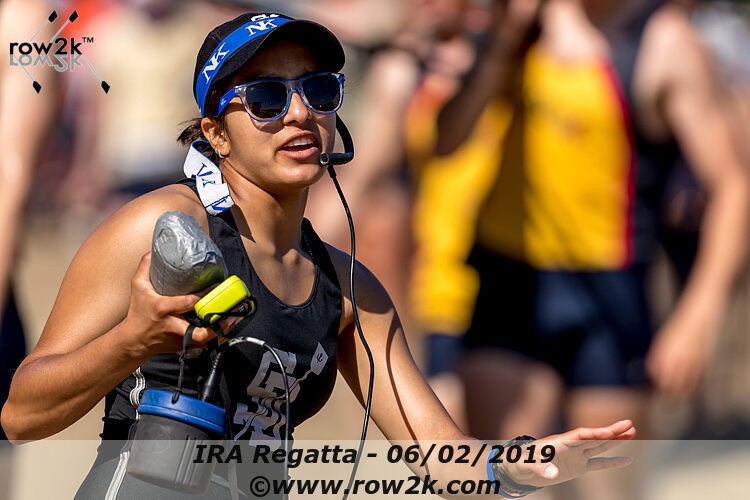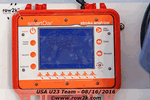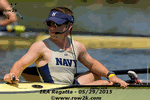Coxswain Development Part 2 - Rhythm, Training, and Evaluation

Following the cancellation of the 2020 spring racing season, row2k solicited the collegiate coaching community to engage in a variety of high-level topics within the profession. We submitted over sixty questions across a dozen topics and thank the coaches and staffs that found time to contribute their thoughts during this stressful time.
This week we focus on the topic of Coxswain Development with the following questions:
HOW DO YOU DESCRIBE BOAT FEEL AND RHYTHM TO COXSWAINS WITH NO ROWING EXPERIENCE?
EMILIE GROSS – NORTH CAROLINA WOMEN
When working with a new/walk-on coxswain, I actually try to approach this question from the erg room utilizing visualization techniques. For example, first we talk about the rower's error, then we visually put the coxswain into a boat and ask them what that error might look like on the water. Finally, from there we discuss how that error we are seeing might feel like. Then of course, then how to fix it.
BART THOMPSON – ADRIAN
Rhythm is consistency, feeling the same sensation over and over again, like a musical beat. For boat feel we start with pointing out when it's good and it's bad, trying to help them feel when it's relaxed and smooth vs. when it's lurching. One thing that really helps is when we put new coxswains in the experienced boats. Getting to experience the contrast between that and the novice boats is really helpful.
SANDRA CHU – WILLIAM SMITH
I think the key to teaching boat feel with a novice comes from helping her to understand when it's right. Many times, we give a novice coxswain the opportunity to ride with the varsity for a practice or two. We also coach the stroke and the concept of rhythm on the water a great deal. It's not just the coxswain who has to understand rhythm but the whole boat, so she knows she has to listen to what the coaches are saying. In fact, in our program, if the coach is talking, the coxswain is not - she's listening and trying to apply what she hears. We teach our coxes how to erg and try to get them rowing in the boat as well. We also coach the change in the moment; if the boat makes a great rhythm change, we point it out immediately and get the coxswain to think about how the boat feels or sounds different.
ROBERT BRADY – FRANKLIN & MARSHALL
Carefully. But I also tell coxswains that boat feel, and rhythm can be under their control, and that it is comparable to driving a car, or even bumper cars. They are the driver and they have the ability, assuming the rowers have some rhythm, to control the speed of the recovery. If they are heavy-footed with the brake of a car and then quick to accelerate, coming to a stop and going again will be pretty jerky. But if they are controlled with the brake and the gas pedals, the rhythm of the car when it stops and goes will be so much smoother.
This is where the coxswain's ability to communicate to the boat plays a role; they have the ability to set the rhythm of the boat by speaking calmly, and with a smooth cadence that rowers can respond to. A rushed or frantic voice will more often than not result in a boat that is rushed and frantic, but a controlled voice can help bring to the boat a sense of calm and fluidity, regardless of rate.
JOHN FX FLYNN – NAVY HEAVYWEIGHT MEN
I tell them to learn about this from the rowers themselves, and we definitely start by pairing new coxswains with experienced strokes, and also by putting experienced Plebe coxswains into upper-class lineups early in the year. Opening that line of communication between coxswain and stroke is really important--it teaches both the coxswain and the crew that they are a unit, and that they have to rely on each other--and more importantly their different but corresponding skill sets; in order to really make the boat go.
HOW IMPORTANT IS IT FOR YOUR COXSWAINS TO PARTICIPATE IN AT LEAST SOME OF THE TRAINING THE ROWERS DO?
JOHN FX FLYNN – NAVY HEAVYWEIGHT MEN
It is really important to the coxswains here at Navy, because they are just as responsible as the rowers are for staying physically fit so that they can do well on the Navy's Physical Readiness Test each semester. Their grade on the PRT is factored into their Overall Order of Merit and their standing within their class, so the Navy coxswains very much see themselves as athletes, too. That is unique to Navy, of course, though I suspect the Army and Coast Guard coxswains would say the same thing--that is life on a Service Academy team.

In a broader sense, I do think that coxswains who do some of the training--because ALL of the training really isn't possible since they cannot make up for the time they spend coxing, can develop a better rapport with the rowers. At the same time, I have certainly had great coxswains in my career, here and elsewhere, who did no workouts and were still great leaders. What those coxswains did have, though, was a high degree of empathy for the work, and suffering, of the rowers, and they were good leaders because they really knew the technical side of things. My advice for younger coxswains would be to try to do some of the workouts: that will help you develop that empathy so you can use it down the line, and it will show the team how much you care while you are still developing your technical know-how and leadership skills.
ROBERT BRADY – FRANKLIN & MARSHALL
I think it's great when a coxswain works out with the team, especially if it's a cross training day or during a lift. Some rowers truly appreciate seeing their coxswain sweating alongside them or squatting a few plates in the gym, but I also think that a coxswain can truly benefit and learn from taking a few strokes on an erg or lifting with the team. It'll give them a greater understanding of the stroke, the intensity of pieces, the various muscles that are in use, and what they're asking their rowers to do at a practice or in a race. This really is part of their learning experience.
EMILIE GROSS – NORTH CAROLINA WOMEN
If it's on land (off of the erg), a coxswain should participate. A coxswain's job is to ultimately make their rowers better, which essentially means faster. No matter what personal speed a coxswain is, let's say in a team run, they need to find the group of rowers around them and make them just slighter faster during that piece. I also believe this earns respect from teammates during the process.
SANDRA CHU – WILLIAM SMITH
It's vital. Coxswains needs to experience the struggle, plus it's helpful for weight management.
BART THOMPSON – ADRIAN
I think it's hugely important. We talk about "sweat equity," taking advantage of any opportunity that they get to work hard alongside the rowers to further gain their trust and respect. So, they're on the spin bikes whenever possible, they're lifting whenever it works out in the schedule, and they're participating in the on-land circuits whenever possible.
JOHN BOYD – IONA
Our coxswains do almost all of the training the rowers do, including erg tests. Having an engaged coxswain is critical to the process.
TO WHAT EXTENT DO YOU SEEK ROWER FEEDBACK REGARDING COXSWAIN DEVELOPMENT AND SELECTION?
SANDRA CHU – WILLIAM SMITH
We use a quick coxswain feedback form, typically during spring break, that helps the rower give feedback directly to the coxswain. For selection, if I believe all skills are equal, I will use a coxswain evaluation form (which provides quantitative feedback) that includes a question for selection. I have found that it is hard sometimes for rowers to understand that just because they like a coxswain better than another doesn't mean the likable coxswain actually helps them train at a higher standard or perform more successfully. By knowing which rowers have the skill to be more neutral than others, I believe I can use their feedback more wisely.
ROBERT BRADY – FRANKLIN & MARSHALL
Two to three times a season I'll seek feedback from rowers on coxswains, which can be useful when it comes from the rowers who take coxswain evaluations seriously. Rowers are in the boats daily with the coxswain and build up an understanding of what is working or what needs some changes. This is important information that I can't always get when riding in the launch, unless we decide to record and listen to coxswain audio daily. And seeking feedback multiple times a season really allows me to gauge how a coxswain is developing over time, and I can use this information in our weekly coxswain meetings.

At the same time, this feedback provides me some insight into how rowers view coxswains; as in do they respect them as valuable members of the team and are coxswains worth the time to share their insights. I've been around a few programs as a rower and as a coach where coxswains were overly criticized or treated differently by the rowers, or even by coaches, and I don't think that is fair. They are essential members of the team, and I think that rowers who provide thoughtful feedback on coxswains understand that and show that they too hold a coxswain and his or her role on the team in higher regard.
JOHN BOYD – IONA
Survey monkey is a great tool to get anonymous feedback from the rowers.
JOHN FX FLYNN – NAVY HEAVYWEIGHT MEN
This will vary by the experience level of the crew: with novice crews, I usually will not seek their input, especially if I am trying to develop a newer coxswain or if I am not sure that the novice rowers are thinking about the right criteria. They might want the "motivating" coxswain, for instance, whereas I can see that a more technical coxswain is actually better for that group, or I just want someone in there who says nothing but steers really, really well.
With more experienced crews, I think the rowers should decide who they want to race with. Just as the coxswains are looking at erg scores and seat racing results to think about who they want in their boat; the rowers should get to decide who they want to pilot the boat. And it is really interesting: some crews want the "racer" to drive the boat, others can see that a calmer presence and a technical eye is what really helps their crew. Plus, no one knows more about how that coxswains' steers than the guys in the boat. You can't hide the squiggles on the river from the stern pair!
EMILIE GROSS – NORTH CAROLINA WOMEN
I think it is important to have an understanding of the rower's feedback, and specific to the groupings of the rowers when it comes to coxswain selection. I do not believe it is always the final answer to how a coxswain is selected, but rather a tool to help similar to 2k erg score.
BART THOMPSON – ADRIAN
I seek it a great deal. There are coxswains who seem to do everything right in practice, but then we get feedback from the rowers about the races and the consensus is that they are overwhelmed, anxious, etc. Ultimately, the rowers need to trust the coxswain and believe in the coxswain's ability; belief leads to confident, high-quality racing.
If you enjoy and rely on row2k, we need your help to be able to keep doing all this. Though row2k sometimes looks like a big, outside-funded operation, it mainly runs on enthusiasm and grit. Help us keep it coming, thank you! Learn more.
Comments | Log in to comment |
There are no Comments yet
| |
- Bont Rowing
- Calm Waters Rowing
- Concept 2
- Craftsbury Sculling
- The Crew Classic
- CrewLAB
- Croker
- Durham Boat Co.
- Empacher
- Faster Masters
- Filippi
- Fluidesign
- h2row.net
- HUDSON
- Live2Row Studios
- Nielsen-Kellerman
- Oak Ridge RA
- Peinert Boat Works
- Pocock Racing Shells
- Race1 USA
- RowKraft
- Rubini Jewelers
- Vespoli USA
- WinTech Racing
- Bont Rowing
- Calm Waters Rowing
- Concept 2
- Craftsbury Sculling
- The Crew Classic
- CrewLAB
- Croker
- Durham Boat Co.
- Empacher
- Faster Masters
- Filippi
- Fluidesign
- h2row.net
- HUDSON
- Live2Row Studios
- Nielsen-Kellerman
- Oak Ridge RA
- Peinert Boat Works
- Pocock Racing Shells
- Race1 USA
- RowKraft
- Rubini Jewelers
- Vespoli USA
- WinTech Racing


















